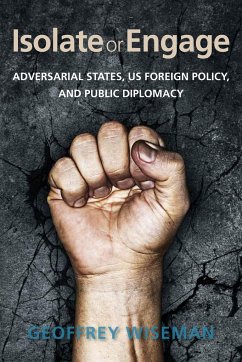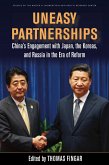Isolate or Engage
Adversarial States, Us Foreign Policy, and Public Diplomacy
Herausgeber: Wiseman, Geoffrey
Isolate or Engage
Adversarial States, Us Foreign Policy, and Public Diplomacy
Herausgeber: Wiseman, Geoffrey
- Broschiertes Buch
- Merkliste
- Auf die Merkliste
- Bewerten Bewerten
- Teilen
- Produkt teilen
- Produkterinnerung
- Produkterinnerung
Geoffrey Wiseman is Professor of the Practice of International Relations, University of Southern California.
Andere Kunden interessierten sich auch für
![Normalizing Japan Normalizing Japan]() Andrew L OrosNormalizing Japan30,99 €
Andrew L OrosNormalizing Japan30,99 €![Intelligence Analysis and Policy Making Intelligence Analysis and Policy Making]() Thomas JuneauIntelligence Analysis and Policy Making34,99 €
Thomas JuneauIntelligence Analysis and Policy Making34,99 €![Uneasy Partnerships Uneasy Partnerships]() Uneasy Partnerships30,99 €
Uneasy Partnerships30,99 €![Battleground Africa Battleground Africa]() Lise NamikasBattleground Africa42,99 €
Lise NamikasBattleground Africa42,99 €![Working Mothers and the Welfare State Working Mothers and the Welfare State]() Kimberly J MorganWorking Mothers and the Welfare State27,99 €
Kimberly J MorganWorking Mothers and the Welfare State27,99 €![Iranophobia Iranophobia]() Haggai RamIranophobia22,99 €
Haggai RamIranophobia22,99 €![Negotiations Negotiations]() Jacques DerridaNegotiations36,99 €
Jacques DerridaNegotiations36,99 €-
-
-
Geoffrey Wiseman is Professor of the Practice of International Relations, University of Southern California.
Hinweis: Dieser Artikel kann nur an eine deutsche Lieferadresse ausgeliefert werden.
Hinweis: Dieser Artikel kann nur an eine deutsche Lieferadresse ausgeliefert werden.
Produktdetails
- Produktdetails
- Verlag: Stanford University Press
- Seitenzahl: 327
- Erscheinungstermin: 24. Juni 2015
- Englisch
- Abmessung: 228mm x 151mm x 22mm
- Gewicht: 453g
- ISBN-13: 9780804795524
- ISBN-10: 0804795525
- Artikelnr.: 41751786
- Herstellerkennzeichnung
- Libri GmbH
- Europaallee 1
- 36244 Bad Hersfeld
- gpsr@libri.de
- Verlag: Stanford University Press
- Seitenzahl: 327
- Erscheinungstermin: 24. Juni 2015
- Englisch
- Abmessung: 228mm x 151mm x 22mm
- Gewicht: 453g
- ISBN-13: 9780804795524
- ISBN-10: 0804795525
- Artikelnr.: 41751786
- Herstellerkennzeichnung
- Libri GmbH
- Europaallee 1
- 36244 Bad Hersfeld
- gpsr@libri.de
Geoffrey Wiseman is Professor of the Practice of International Relations, University of Southern California.
Contents and Abstracts
Introduction: Introduction
chapter abstract
The Introduction explains how the book addresses the policy puzzle of
how-in the absence or limited presence of official diplomatic relations-the
United States goes about seeking to influence or engage an adversarial
state's public so that it will influence its own government to adopt less
hostile views of US foreign policies and of American society. The
Introduction describes the "adversarial state" concept, lists the criteria
used in choosing the nine cases, justifies the choice of multidisciplinary
experts to write the case studies, lists the framing questions that set the
broad parameters for the cases, and addresses key definitional issues. It
also describes a three-part definitional framework for public diplomacy,
and concludes with a brief description of the nine cases. It suggests that
the cases are especially hard ones that potentially contribute to three
fields of study: international security studies, diplomatic studies, and
public diplomacy.
1USSR/RUSSIA: US Diplomacy with the Russian "Adversary"
chapter abstract
Drawing on the epoch-spanning experience of three distinguished Princeton
scholar-diplomats-George Kennan, Robert Tucker, and Jack Matlock-this
chapter examines US diplomacy with Russia from the time of Lenin's 1917
Revolution to Putin's Russia of today. The chapter endorses the importance
of active, multifaceted diplomatic engagement even in periods, and with
regimes, of greatest hostility. A lack of such engagement leads to
stereotypes and ignorance-and lost opportunities-while its presence
contributed much to the Cold War's end. An underappreciated facet of that
engagement has been public diplomacy. Regrettably, at the outset of
relations with post-Soviet Russia, public diplomacy fared poorly: partly
from clumsy "salesmanship," but even more because the "product" proved
disappointing.
2CHINA: American Public Diplomacy and US-China Relations, 1949-2012
chapter abstract
US-China relations since 1949 have been characterized by periodic swings
between enmity (1949-1973), cooperation (1973-1989), and traditional Great
Power competition (post-1989). The chapter assesses the impact of US public
diplomacy on post-1949 US-China relations. It addresses whether the absence
or presence of American public diplomacy has affected the degree of
US-China conflict and cooperation. The chapter examines public diplomacy
from two perspectives. First, for each post-1949 period it considers the
influence of the US diplomatic presence in China and US-China ambassadorial
relations on cooperation and conflict. Second, for each period it also
examines the role of less formal and less direct US government efforts to
shape US-China relations, including government outreach programs such as
the Voice of America (VOA) and cultural programs.
3NORTH KOREA: Engaging a Hermit Adversarial State
chapter abstract
The opportunity for effective public diplomacy in the US-DPRK relationship
has been limited. The ongoing hostility (and lack of diplomatic
representation) between the two sides is an obstacle to expanded public
diplomacy toward North Korea, and North Korea's own domestic political
constraints suggest that the prospects for fashioning an effective message
that can reach the North Korean people remain dim. The nuclear issue
overall has been a dampening factor on the development of official
relations as well as on public diplomacy efforts to facilitate
negotiations, despite the public roles of skillful nonresident envoys. For
improvement to occur, US-DPRK relations need to be improved in tandem with
progress in inter-Korean reconciliation. US diplomacy toward North Korea
must consider its ally in the South and its key regional partner Japan.
Hopes that new leader Kim Jong Un would herald public diplomacy
opportunities for the United States have proven premature.
4VIETNAM: American and Vietnamese Public Diplomacy, 1945-2010
chapter abstract
This case suggests that in attempting to understand American efforts to
influence its Vietnamese adversary, via what might loosely be called
"public diplomacy," it is necessary to analyze a broad range of actors.
Traditional government units (the State Department and its embassies in
Saigon during the war and in Hanoi after normalization) and the military's
wartime public communication activities, along with nongovernmental actors
funded or facilitated by the US government, have all played a role in
US-Vietnamese public diplomacy. However, the authors have also included
civil society actors with little or no direct connection to the government
(some of whom oppose government policy). This chapter also gives weight to
Vietnamese public diplomacy, signaling that public diplomacy among
adversaries is a highly interactive, dialogic practice.
5LIBYA: The United States and the Libyan Jamahiriyya: From Isolation to
Regional Ally, 1969-2011
chapter abstract
This chapter analyzes US diplomacy and its public manifestations toward
Libya during the period when Libya was ruled by the Muammar Qadhafi
regime-from the 1969 military coup until the country's 2011 uprising
against the Libyan dictator. After flouting international norms for many
years, the Qadhafi regime eventually adhered to many of those norms,
renouncing WMDs, the most powerful bargaining chip at its disposal. Libya's
changing behavior represented the outcome of a long process of coordinated,
behind-the-scenes diplomatic actions by the United States, Great Britain,
and, eventually, the international community.
6IRAN: Public Diplomacy in a Vacuum
chapter abstract
US public diplomacy toward Iran-rhetoric, messaging, and direct engagement
with the Iranian people-constitute critical tools for advancing American
interests vis-à-vis Iran, assuming the role that traditional diplomacy
serves elsewhere. The Iran case highlights pitfalls of a diplomatic
approach that is overly dependent on public diplomacy instruments. They can
inflame the suspicions of the intended recipients and are inadequate for
promoting vital security interests such as nuclear nonproliferation.
Resolving the most urgent disputes between Washington and Tehran will
require a reversion to the traditional tools of formal diplomacy,
especially formal diplomatic engagement involving the reciprocal exchange
of embassies.
7American Public Diplomacy in Syria: Overcoming Obstacles
chapter abstract
The Syrian case shows that a crucial element in the US public diplomacy
effort is the existence of a functioning US embassy, and private
organizations play only a minor role. When the embassy was open, public
diplomacy personnel showed creativity by using English-language teaching,
cultural programming, and careful personal contacts effectively to work
around Syrian governmental restrictions. It shows also that domestic
pressures hampered the public diplomacy effort when Congress tried to
prevent Ambassador Robert Ford's return to Damascus. Ford enhanced public
diplomacy by his visible presence and his creative use of social media. But
when the deteriorating security situation forced his withdrawal and the
embassy's closure, US public diplomacy was reduced to an offshore effort by
radio and television, and a new virtual embassy managed in Washington.
8CUBA: Public Diplomacy as a Battle of Ideas
chapter abstract
The history of US public diplomacy toward Cuba suggested little hope that
government-organized and -targeted initiatives were likely to be effective.
Covert efforts designed to undercut Fidel Castro's popular support and
overthrow his government not only failed but, worse, helped Castro mobilize
nationalist sentiment. Offshore broadcasting programs had no noticeable
impact. The biggest impact in Cuba came not from public diplomacy efforts
orchestrated by government, but instead from instances where the government
got out of the way to allow open, authentic people-to-people contact. Under
Raúl Castro, Cuba hinted that it would prefer to have more normal relations
with the United States. With the December 2014 announcement that both
countries would move toward normalization, the United States is now better
positioned than any other country to influence Cuba's future trajectory
through engagement.
9The United States and Venezuela: Managing a Schizophrenic Relationship
chapter abstract
Hugo Chávez's fourteen-year rule in Venezuela from 1999 to 2013 was
distinguished by a notably adversarial posture toward the United States.
The case offers a number of insights: The role of a mercurial personality,
with a lot of money to spend, leading a weaker state that attempts to
employ public diplomacy to throw its more powerful adversary off balance.
The case suggests that while necessary in the Venezuela case to consider
traditional "State Department public diplomacy" activities, they are not
sufficient to prevent bilateral relations from getting out of
controlprevent bilateral relations from getting out of control. It is also
crucial to consider "whole-of-government diplomacy" involving many
government agencies, plus the often-neglected role of corporate and other
key nonstate "new public diplomacy" actors.
Conclusion
chapter abstract
The Conclusion summarizes the findings of the nine case studies and
suggests that the United States will need to judiciously balance all three
public diplomacy approaches outlined in the Introduction: (1) the narrow
"traditional government to foreign public" approach; (2) the middle-ground
"whole of government to foreign public" approach; and (3) the broadened
approach of a "new public diplomacy," one that is conducted by a wide range
of governmental and, especially, nongovernmental actors. However, there is
a fourth conceptual possibility that public diplomacy is best left almost
entirely to publics dealing directly with other publics.
Introduction: Introduction
chapter abstract
The Introduction explains how the book addresses the policy puzzle of
how-in the absence or limited presence of official diplomatic relations-the
United States goes about seeking to influence or engage an adversarial
state's public so that it will influence its own government to adopt less
hostile views of US foreign policies and of American society. The
Introduction describes the "adversarial state" concept, lists the criteria
used in choosing the nine cases, justifies the choice of multidisciplinary
experts to write the case studies, lists the framing questions that set the
broad parameters for the cases, and addresses key definitional issues. It
also describes a three-part definitional framework for public diplomacy,
and concludes with a brief description of the nine cases. It suggests that
the cases are especially hard ones that potentially contribute to three
fields of study: international security studies, diplomatic studies, and
public diplomacy.
1USSR/RUSSIA: US Diplomacy with the Russian "Adversary"
chapter abstract
Drawing on the epoch-spanning experience of three distinguished Princeton
scholar-diplomats-George Kennan, Robert Tucker, and Jack Matlock-this
chapter examines US diplomacy with Russia from the time of Lenin's 1917
Revolution to Putin's Russia of today. The chapter endorses the importance
of active, multifaceted diplomatic engagement even in periods, and with
regimes, of greatest hostility. A lack of such engagement leads to
stereotypes and ignorance-and lost opportunities-while its presence
contributed much to the Cold War's end. An underappreciated facet of that
engagement has been public diplomacy. Regrettably, at the outset of
relations with post-Soviet Russia, public diplomacy fared poorly: partly
from clumsy "salesmanship," but even more because the "product" proved
disappointing.
2CHINA: American Public Diplomacy and US-China Relations, 1949-2012
chapter abstract
US-China relations since 1949 have been characterized by periodic swings
between enmity (1949-1973), cooperation (1973-1989), and traditional Great
Power competition (post-1989). The chapter assesses the impact of US public
diplomacy on post-1949 US-China relations. It addresses whether the absence
or presence of American public diplomacy has affected the degree of
US-China conflict and cooperation. The chapter examines public diplomacy
from two perspectives. First, for each post-1949 period it considers the
influence of the US diplomatic presence in China and US-China ambassadorial
relations on cooperation and conflict. Second, for each period it also
examines the role of less formal and less direct US government efforts to
shape US-China relations, including government outreach programs such as
the Voice of America (VOA) and cultural programs.
3NORTH KOREA: Engaging a Hermit Adversarial State
chapter abstract
The opportunity for effective public diplomacy in the US-DPRK relationship
has been limited. The ongoing hostility (and lack of diplomatic
representation) between the two sides is an obstacle to expanded public
diplomacy toward North Korea, and North Korea's own domestic political
constraints suggest that the prospects for fashioning an effective message
that can reach the North Korean people remain dim. The nuclear issue
overall has been a dampening factor on the development of official
relations as well as on public diplomacy efforts to facilitate
negotiations, despite the public roles of skillful nonresident envoys. For
improvement to occur, US-DPRK relations need to be improved in tandem with
progress in inter-Korean reconciliation. US diplomacy toward North Korea
must consider its ally in the South and its key regional partner Japan.
Hopes that new leader Kim Jong Un would herald public diplomacy
opportunities for the United States have proven premature.
4VIETNAM: American and Vietnamese Public Diplomacy, 1945-2010
chapter abstract
This case suggests that in attempting to understand American efforts to
influence its Vietnamese adversary, via what might loosely be called
"public diplomacy," it is necessary to analyze a broad range of actors.
Traditional government units (the State Department and its embassies in
Saigon during the war and in Hanoi after normalization) and the military's
wartime public communication activities, along with nongovernmental actors
funded or facilitated by the US government, have all played a role in
US-Vietnamese public diplomacy. However, the authors have also included
civil society actors with little or no direct connection to the government
(some of whom oppose government policy). This chapter also gives weight to
Vietnamese public diplomacy, signaling that public diplomacy among
adversaries is a highly interactive, dialogic practice.
5LIBYA: The United States and the Libyan Jamahiriyya: From Isolation to
Regional Ally, 1969-2011
chapter abstract
This chapter analyzes US diplomacy and its public manifestations toward
Libya during the period when Libya was ruled by the Muammar Qadhafi
regime-from the 1969 military coup until the country's 2011 uprising
against the Libyan dictator. After flouting international norms for many
years, the Qadhafi regime eventually adhered to many of those norms,
renouncing WMDs, the most powerful bargaining chip at its disposal. Libya's
changing behavior represented the outcome of a long process of coordinated,
behind-the-scenes diplomatic actions by the United States, Great Britain,
and, eventually, the international community.
6IRAN: Public Diplomacy in a Vacuum
chapter abstract
US public diplomacy toward Iran-rhetoric, messaging, and direct engagement
with the Iranian people-constitute critical tools for advancing American
interests vis-à-vis Iran, assuming the role that traditional diplomacy
serves elsewhere. The Iran case highlights pitfalls of a diplomatic
approach that is overly dependent on public diplomacy instruments. They can
inflame the suspicions of the intended recipients and are inadequate for
promoting vital security interests such as nuclear nonproliferation.
Resolving the most urgent disputes between Washington and Tehran will
require a reversion to the traditional tools of formal diplomacy,
especially formal diplomatic engagement involving the reciprocal exchange
of embassies.
7American Public Diplomacy in Syria: Overcoming Obstacles
chapter abstract
The Syrian case shows that a crucial element in the US public diplomacy
effort is the existence of a functioning US embassy, and private
organizations play only a minor role. When the embassy was open, public
diplomacy personnel showed creativity by using English-language teaching,
cultural programming, and careful personal contacts effectively to work
around Syrian governmental restrictions. It shows also that domestic
pressures hampered the public diplomacy effort when Congress tried to
prevent Ambassador Robert Ford's return to Damascus. Ford enhanced public
diplomacy by his visible presence and his creative use of social media. But
when the deteriorating security situation forced his withdrawal and the
embassy's closure, US public diplomacy was reduced to an offshore effort by
radio and television, and a new virtual embassy managed in Washington.
8CUBA: Public Diplomacy as a Battle of Ideas
chapter abstract
The history of US public diplomacy toward Cuba suggested little hope that
government-organized and -targeted initiatives were likely to be effective.
Covert efforts designed to undercut Fidel Castro's popular support and
overthrow his government not only failed but, worse, helped Castro mobilize
nationalist sentiment. Offshore broadcasting programs had no noticeable
impact. The biggest impact in Cuba came not from public diplomacy efforts
orchestrated by government, but instead from instances where the government
got out of the way to allow open, authentic people-to-people contact. Under
Raúl Castro, Cuba hinted that it would prefer to have more normal relations
with the United States. With the December 2014 announcement that both
countries would move toward normalization, the United States is now better
positioned than any other country to influence Cuba's future trajectory
through engagement.
9The United States and Venezuela: Managing a Schizophrenic Relationship
chapter abstract
Hugo Chávez's fourteen-year rule in Venezuela from 1999 to 2013 was
distinguished by a notably adversarial posture toward the United States.
The case offers a number of insights: The role of a mercurial personality,
with a lot of money to spend, leading a weaker state that attempts to
employ public diplomacy to throw its more powerful adversary off balance.
The case suggests that while necessary in the Venezuela case to consider
traditional "State Department public diplomacy" activities, they are not
sufficient to prevent bilateral relations from getting out of
controlprevent bilateral relations from getting out of control. It is also
crucial to consider "whole-of-government diplomacy" involving many
government agencies, plus the often-neglected role of corporate and other
key nonstate "new public diplomacy" actors.
Conclusion
chapter abstract
The Conclusion summarizes the findings of the nine case studies and
suggests that the United States will need to judiciously balance all three
public diplomacy approaches outlined in the Introduction: (1) the narrow
"traditional government to foreign public" approach; (2) the middle-ground
"whole of government to foreign public" approach; and (3) the broadened
approach of a "new public diplomacy," one that is conducted by a wide range
of governmental and, especially, nongovernmental actors. However, there is
a fourth conceptual possibility that public diplomacy is best left almost
entirely to publics dealing directly with other publics.
Contents and Abstracts
Introduction: Introduction
chapter abstract
The Introduction explains how the book addresses the policy puzzle of
how-in the absence or limited presence of official diplomatic relations-the
United States goes about seeking to influence or engage an adversarial
state's public so that it will influence its own government to adopt less
hostile views of US foreign policies and of American society. The
Introduction describes the "adversarial state" concept, lists the criteria
used in choosing the nine cases, justifies the choice of multidisciplinary
experts to write the case studies, lists the framing questions that set the
broad parameters for the cases, and addresses key definitional issues. It
also describes a three-part definitional framework for public diplomacy,
and concludes with a brief description of the nine cases. It suggests that
the cases are especially hard ones that potentially contribute to three
fields of study: international security studies, diplomatic studies, and
public diplomacy.
1USSR/RUSSIA: US Diplomacy with the Russian "Adversary"
chapter abstract
Drawing on the epoch-spanning experience of three distinguished Princeton
scholar-diplomats-George Kennan, Robert Tucker, and Jack Matlock-this
chapter examines US diplomacy with Russia from the time of Lenin's 1917
Revolution to Putin's Russia of today. The chapter endorses the importance
of active, multifaceted diplomatic engagement even in periods, and with
regimes, of greatest hostility. A lack of such engagement leads to
stereotypes and ignorance-and lost opportunities-while its presence
contributed much to the Cold War's end. An underappreciated facet of that
engagement has been public diplomacy. Regrettably, at the outset of
relations with post-Soviet Russia, public diplomacy fared poorly: partly
from clumsy "salesmanship," but even more because the "product" proved
disappointing.
2CHINA: American Public Diplomacy and US-China Relations, 1949-2012
chapter abstract
US-China relations since 1949 have been characterized by periodic swings
between enmity (1949-1973), cooperation (1973-1989), and traditional Great
Power competition (post-1989). The chapter assesses the impact of US public
diplomacy on post-1949 US-China relations. It addresses whether the absence
or presence of American public diplomacy has affected the degree of
US-China conflict and cooperation. The chapter examines public diplomacy
from two perspectives. First, for each post-1949 period it considers the
influence of the US diplomatic presence in China and US-China ambassadorial
relations on cooperation and conflict. Second, for each period it also
examines the role of less formal and less direct US government efforts to
shape US-China relations, including government outreach programs such as
the Voice of America (VOA) and cultural programs.
3NORTH KOREA: Engaging a Hermit Adversarial State
chapter abstract
The opportunity for effective public diplomacy in the US-DPRK relationship
has been limited. The ongoing hostility (and lack of diplomatic
representation) between the two sides is an obstacle to expanded public
diplomacy toward North Korea, and North Korea's own domestic political
constraints suggest that the prospects for fashioning an effective message
that can reach the North Korean people remain dim. The nuclear issue
overall has been a dampening factor on the development of official
relations as well as on public diplomacy efforts to facilitate
negotiations, despite the public roles of skillful nonresident envoys. For
improvement to occur, US-DPRK relations need to be improved in tandem with
progress in inter-Korean reconciliation. US diplomacy toward North Korea
must consider its ally in the South and its key regional partner Japan.
Hopes that new leader Kim Jong Un would herald public diplomacy
opportunities for the United States have proven premature.
4VIETNAM: American and Vietnamese Public Diplomacy, 1945-2010
chapter abstract
This case suggests that in attempting to understand American efforts to
influence its Vietnamese adversary, via what might loosely be called
"public diplomacy," it is necessary to analyze a broad range of actors.
Traditional government units (the State Department and its embassies in
Saigon during the war and in Hanoi after normalization) and the military's
wartime public communication activities, along with nongovernmental actors
funded or facilitated by the US government, have all played a role in
US-Vietnamese public diplomacy. However, the authors have also included
civil society actors with little or no direct connection to the government
(some of whom oppose government policy). This chapter also gives weight to
Vietnamese public diplomacy, signaling that public diplomacy among
adversaries is a highly interactive, dialogic practice.
5LIBYA: The United States and the Libyan Jamahiriyya: From Isolation to
Regional Ally, 1969-2011
chapter abstract
This chapter analyzes US diplomacy and its public manifestations toward
Libya during the period when Libya was ruled by the Muammar Qadhafi
regime-from the 1969 military coup until the country's 2011 uprising
against the Libyan dictator. After flouting international norms for many
years, the Qadhafi regime eventually adhered to many of those norms,
renouncing WMDs, the most powerful bargaining chip at its disposal. Libya's
changing behavior represented the outcome of a long process of coordinated,
behind-the-scenes diplomatic actions by the United States, Great Britain,
and, eventually, the international community.
6IRAN: Public Diplomacy in a Vacuum
chapter abstract
US public diplomacy toward Iran-rhetoric, messaging, and direct engagement
with the Iranian people-constitute critical tools for advancing American
interests vis-à-vis Iran, assuming the role that traditional diplomacy
serves elsewhere. The Iran case highlights pitfalls of a diplomatic
approach that is overly dependent on public diplomacy instruments. They can
inflame the suspicions of the intended recipients and are inadequate for
promoting vital security interests such as nuclear nonproliferation.
Resolving the most urgent disputes between Washington and Tehran will
require a reversion to the traditional tools of formal diplomacy,
especially formal diplomatic engagement involving the reciprocal exchange
of embassies.
7American Public Diplomacy in Syria: Overcoming Obstacles
chapter abstract
The Syrian case shows that a crucial element in the US public diplomacy
effort is the existence of a functioning US embassy, and private
organizations play only a minor role. When the embassy was open, public
diplomacy personnel showed creativity by using English-language teaching,
cultural programming, and careful personal contacts effectively to work
around Syrian governmental restrictions. It shows also that domestic
pressures hampered the public diplomacy effort when Congress tried to
prevent Ambassador Robert Ford's return to Damascus. Ford enhanced public
diplomacy by his visible presence and his creative use of social media. But
when the deteriorating security situation forced his withdrawal and the
embassy's closure, US public diplomacy was reduced to an offshore effort by
radio and television, and a new virtual embassy managed in Washington.
8CUBA: Public Diplomacy as a Battle of Ideas
chapter abstract
The history of US public diplomacy toward Cuba suggested little hope that
government-organized and -targeted initiatives were likely to be effective.
Covert efforts designed to undercut Fidel Castro's popular support and
overthrow his government not only failed but, worse, helped Castro mobilize
nationalist sentiment. Offshore broadcasting programs had no noticeable
impact. The biggest impact in Cuba came not from public diplomacy efforts
orchestrated by government, but instead from instances where the government
got out of the way to allow open, authentic people-to-people contact. Under
Raúl Castro, Cuba hinted that it would prefer to have more normal relations
with the United States. With the December 2014 announcement that both
countries would move toward normalization, the United States is now better
positioned than any other country to influence Cuba's future trajectory
through engagement.
9The United States and Venezuela: Managing a Schizophrenic Relationship
chapter abstract
Hugo Chávez's fourteen-year rule in Venezuela from 1999 to 2013 was
distinguished by a notably adversarial posture toward the United States.
The case offers a number of insights: The role of a mercurial personality,
with a lot of money to spend, leading a weaker state that attempts to
employ public diplomacy to throw its more powerful adversary off balance.
The case suggests that while necessary in the Venezuela case to consider
traditional "State Department public diplomacy" activities, they are not
sufficient to prevent bilateral relations from getting out of
controlprevent bilateral relations from getting out of control. It is also
crucial to consider "whole-of-government diplomacy" involving many
government agencies, plus the often-neglected role of corporate and other
key nonstate "new public diplomacy" actors.
Conclusion
chapter abstract
The Conclusion summarizes the findings of the nine case studies and
suggests that the United States will need to judiciously balance all three
public diplomacy approaches outlined in the Introduction: (1) the narrow
"traditional government to foreign public" approach; (2) the middle-ground
"whole of government to foreign public" approach; and (3) the broadened
approach of a "new public diplomacy," one that is conducted by a wide range
of governmental and, especially, nongovernmental actors. However, there is
a fourth conceptual possibility that public diplomacy is best left almost
entirely to publics dealing directly with other publics.
Introduction: Introduction
chapter abstract
The Introduction explains how the book addresses the policy puzzle of
how-in the absence or limited presence of official diplomatic relations-the
United States goes about seeking to influence or engage an adversarial
state's public so that it will influence its own government to adopt less
hostile views of US foreign policies and of American society. The
Introduction describes the "adversarial state" concept, lists the criteria
used in choosing the nine cases, justifies the choice of multidisciplinary
experts to write the case studies, lists the framing questions that set the
broad parameters for the cases, and addresses key definitional issues. It
also describes a three-part definitional framework for public diplomacy,
and concludes with a brief description of the nine cases. It suggests that
the cases are especially hard ones that potentially contribute to three
fields of study: international security studies, diplomatic studies, and
public diplomacy.
1USSR/RUSSIA: US Diplomacy with the Russian "Adversary"
chapter abstract
Drawing on the epoch-spanning experience of three distinguished Princeton
scholar-diplomats-George Kennan, Robert Tucker, and Jack Matlock-this
chapter examines US diplomacy with Russia from the time of Lenin's 1917
Revolution to Putin's Russia of today. The chapter endorses the importance
of active, multifaceted diplomatic engagement even in periods, and with
regimes, of greatest hostility. A lack of such engagement leads to
stereotypes and ignorance-and lost opportunities-while its presence
contributed much to the Cold War's end. An underappreciated facet of that
engagement has been public diplomacy. Regrettably, at the outset of
relations with post-Soviet Russia, public diplomacy fared poorly: partly
from clumsy "salesmanship," but even more because the "product" proved
disappointing.
2CHINA: American Public Diplomacy and US-China Relations, 1949-2012
chapter abstract
US-China relations since 1949 have been characterized by periodic swings
between enmity (1949-1973), cooperation (1973-1989), and traditional Great
Power competition (post-1989). The chapter assesses the impact of US public
diplomacy on post-1949 US-China relations. It addresses whether the absence
or presence of American public diplomacy has affected the degree of
US-China conflict and cooperation. The chapter examines public diplomacy
from two perspectives. First, for each post-1949 period it considers the
influence of the US diplomatic presence in China and US-China ambassadorial
relations on cooperation and conflict. Second, for each period it also
examines the role of less formal and less direct US government efforts to
shape US-China relations, including government outreach programs such as
the Voice of America (VOA) and cultural programs.
3NORTH KOREA: Engaging a Hermit Adversarial State
chapter abstract
The opportunity for effective public diplomacy in the US-DPRK relationship
has been limited. The ongoing hostility (and lack of diplomatic
representation) between the two sides is an obstacle to expanded public
diplomacy toward North Korea, and North Korea's own domestic political
constraints suggest that the prospects for fashioning an effective message
that can reach the North Korean people remain dim. The nuclear issue
overall has been a dampening factor on the development of official
relations as well as on public diplomacy efforts to facilitate
negotiations, despite the public roles of skillful nonresident envoys. For
improvement to occur, US-DPRK relations need to be improved in tandem with
progress in inter-Korean reconciliation. US diplomacy toward North Korea
must consider its ally in the South and its key regional partner Japan.
Hopes that new leader Kim Jong Un would herald public diplomacy
opportunities for the United States have proven premature.
4VIETNAM: American and Vietnamese Public Diplomacy, 1945-2010
chapter abstract
This case suggests that in attempting to understand American efforts to
influence its Vietnamese adversary, via what might loosely be called
"public diplomacy," it is necessary to analyze a broad range of actors.
Traditional government units (the State Department and its embassies in
Saigon during the war and in Hanoi after normalization) and the military's
wartime public communication activities, along with nongovernmental actors
funded or facilitated by the US government, have all played a role in
US-Vietnamese public diplomacy. However, the authors have also included
civil society actors with little or no direct connection to the government
(some of whom oppose government policy). This chapter also gives weight to
Vietnamese public diplomacy, signaling that public diplomacy among
adversaries is a highly interactive, dialogic practice.
5LIBYA: The United States and the Libyan Jamahiriyya: From Isolation to
Regional Ally, 1969-2011
chapter abstract
This chapter analyzes US diplomacy and its public manifestations toward
Libya during the period when Libya was ruled by the Muammar Qadhafi
regime-from the 1969 military coup until the country's 2011 uprising
against the Libyan dictator. After flouting international norms for many
years, the Qadhafi regime eventually adhered to many of those norms,
renouncing WMDs, the most powerful bargaining chip at its disposal. Libya's
changing behavior represented the outcome of a long process of coordinated,
behind-the-scenes diplomatic actions by the United States, Great Britain,
and, eventually, the international community.
6IRAN: Public Diplomacy in a Vacuum
chapter abstract
US public diplomacy toward Iran-rhetoric, messaging, and direct engagement
with the Iranian people-constitute critical tools for advancing American
interests vis-à-vis Iran, assuming the role that traditional diplomacy
serves elsewhere. The Iran case highlights pitfalls of a diplomatic
approach that is overly dependent on public diplomacy instruments. They can
inflame the suspicions of the intended recipients and are inadequate for
promoting vital security interests such as nuclear nonproliferation.
Resolving the most urgent disputes between Washington and Tehran will
require a reversion to the traditional tools of formal diplomacy,
especially formal diplomatic engagement involving the reciprocal exchange
of embassies.
7American Public Diplomacy in Syria: Overcoming Obstacles
chapter abstract
The Syrian case shows that a crucial element in the US public diplomacy
effort is the existence of a functioning US embassy, and private
organizations play only a minor role. When the embassy was open, public
diplomacy personnel showed creativity by using English-language teaching,
cultural programming, and careful personal contacts effectively to work
around Syrian governmental restrictions. It shows also that domestic
pressures hampered the public diplomacy effort when Congress tried to
prevent Ambassador Robert Ford's return to Damascus. Ford enhanced public
diplomacy by his visible presence and his creative use of social media. But
when the deteriorating security situation forced his withdrawal and the
embassy's closure, US public diplomacy was reduced to an offshore effort by
radio and television, and a new virtual embassy managed in Washington.
8CUBA: Public Diplomacy as a Battle of Ideas
chapter abstract
The history of US public diplomacy toward Cuba suggested little hope that
government-organized and -targeted initiatives were likely to be effective.
Covert efforts designed to undercut Fidel Castro's popular support and
overthrow his government not only failed but, worse, helped Castro mobilize
nationalist sentiment. Offshore broadcasting programs had no noticeable
impact. The biggest impact in Cuba came not from public diplomacy efforts
orchestrated by government, but instead from instances where the government
got out of the way to allow open, authentic people-to-people contact. Under
Raúl Castro, Cuba hinted that it would prefer to have more normal relations
with the United States. With the December 2014 announcement that both
countries would move toward normalization, the United States is now better
positioned than any other country to influence Cuba's future trajectory
through engagement.
9The United States and Venezuela: Managing a Schizophrenic Relationship
chapter abstract
Hugo Chávez's fourteen-year rule in Venezuela from 1999 to 2013 was
distinguished by a notably adversarial posture toward the United States.
The case offers a number of insights: The role of a mercurial personality,
with a lot of money to spend, leading a weaker state that attempts to
employ public diplomacy to throw its more powerful adversary off balance.
The case suggests that while necessary in the Venezuela case to consider
traditional "State Department public diplomacy" activities, they are not
sufficient to prevent bilateral relations from getting out of
controlprevent bilateral relations from getting out of control. It is also
crucial to consider "whole-of-government diplomacy" involving many
government agencies, plus the often-neglected role of corporate and other
key nonstate "new public diplomacy" actors.
Conclusion
chapter abstract
The Conclusion summarizes the findings of the nine case studies and
suggests that the United States will need to judiciously balance all three
public diplomacy approaches outlined in the Introduction: (1) the narrow
"traditional government to foreign public" approach; (2) the middle-ground
"whole of government to foreign public" approach; and (3) the broadened
approach of a "new public diplomacy," one that is conducted by a wide range
of governmental and, especially, nongovernmental actors. However, there is
a fourth conceptual possibility that public diplomacy is best left almost
entirely to publics dealing directly with other publics.








